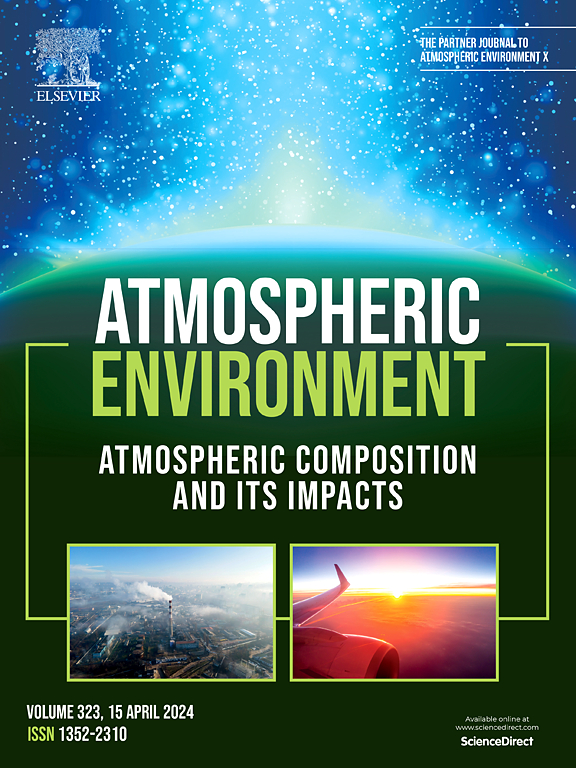印度西北部NO3−颗粒的形成途径及其前体的来源:通过双同位素的见解
IF 3.7
2区 环境科学与生态学
Q2 ENVIRONMENTAL SCIENCES
引用次数: 0
摘要
氮氧化物在对流层臭氧的形成、OH自由基的再循环中起着至关重要的作用,并且是形成颗粒硝酸盐(pNO3-)的前体,pNO3-是一种主要的活性氮。pNO3-主要通过4种途径形成:NO2被OH氧化(P1)、N2O5水解(P2)、与VOCs反应(P3)和ClO反应(P4)。然而,对其来源和形成机制的研究有限。本研究利用pNO3-的双同位素(δ18O和δ15N),探索了印度恒河平原西北部半城市地区帕蒂亚拉大规模水稻秸秆燃烧过程中NOx的来源和pNO3-的主要形成途径。白天δ15N和δ18O平均值分别为- 5.0±2.4‰和52.1±6.2‰,而夜间δ15N和δ18O平均值分别为- 0.13±5.7‰和60.0±8.4‰,反映了较低温度导致夜间分区增强。P1(79.6±7.2%)和P2(16.1±7.5%)主导pNO3-的形成;P3和P4可忽略不计(< 5%)。研究期间,氮氧化物的主要来源为交通尾气(38±18%)、生物质燃烧(29±18%),其次为燃煤电厂(20±11%)和土壤(13±9%)。我们的研究是印度首个此类研究,为特定季节和排放条件下的氮氧化物转化过程提供了宝贵的见解。虽然这些结果提高了对pNO3-形成的理解,并可能有助于改进区域氮氧化物清单,但它们代表了采样的特定地点和时间框架,可能无法反映其他区域或在没有间歇性生物质燃烧影响的时期的源贡献。本文章由计算机程序翻译,如有差异,请以英文原文为准。

Formation pathways of particulate NO3− and sources of its precursor over the northwest India: Insights through dual isotopes
NOx plays a vital role in tropospheric ozone formation, OH radical recycling, and acts as a precursor to the formation of particulate nitrate (pNO3-), a major reactive nitrogen species. pNO3- mainly forms via four pathways: oxidation of NO2 by OH (P1), N2O5 hydrolysis (P2), reactions with VOCs (P3), and ClO (P4). However, studies on its sources and formation mechanisms are limited. This study uses dual isotopes (δ18O and δ15N) of pNO3- to explore the sources of NOx and dominant pNO3- formation pathways over Patiala, a semi-urban site in the northwestern Indo-Gangetic Plain (IGP), during a large-scale paddy residue burning. Day-time δ15N and δ18O averaged −5.0 ± 2.4 ‰ and 52.1 ± 6.2 ‰, while night-time values were −0.13 ± 5.7 ‰ and 60.0 ± 8.4 ‰, respectively, reflecting enhanced nighttime partitioning due to cooler temperatures. Further, P1 (79.6 ± 7.2 %) and P2 (16.1 ± 7.5 %) dominated pNO3- formation; P3 and P4 were negligible (<5 %). During the study period, the major sources of NOx were traffic exhaust (38 ± 18 %), biomass burning (29 ± 18 %), followed by emissions from coal-fired power plants (20 ± 11 %) and soil (13 ± 9 %). Our study, the first of its kind over India provide valuable insight into NOx transformation processes under specific seasonal and emission conditions. While these results improve the understanding of pNO3- formation and may aid in refining regional NOx inventories, they are representative of the particular location and time frame of sampling and may not reflect source contributions in other regions or during periods without episodic biomass burning influence.
求助全文
通过发布文献求助,成功后即可免费获取论文全文。
去求助
来源期刊

Atmospheric Environment
环境科学-环境科学
CiteScore
9.40
自引率
8.00%
发文量
458
审稿时长
53 days
期刊介绍:
Atmospheric Environment has an open access mirror journal Atmospheric Environment: X, sharing the same aims and scope, editorial team, submission system and rigorous peer review.
Atmospheric Environment is the international journal for scientists in different disciplines related to atmospheric composition and its impacts. The journal publishes scientific articles with atmospheric relevance of emissions and depositions of gaseous and particulate compounds, chemical processes and physical effects in the atmosphere, as well as impacts of the changing atmospheric composition on human health, air quality, climate change, and ecosystems.
 求助内容:
求助内容: 应助结果提醒方式:
应助结果提醒方式:


